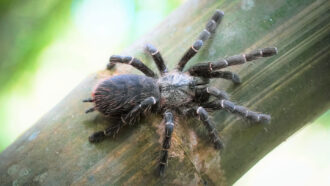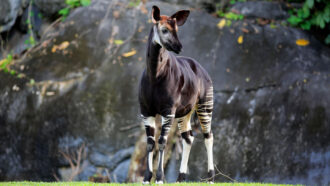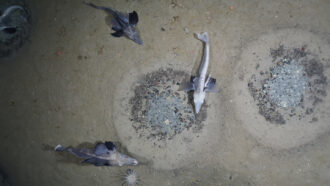Animals
-
 Life
LifeExplainer: Cells and their parts
Life as we know it depends on the coordination of structures inside cells — whether a living thing has only a single cell or trillions of them.
-
 Animals
AnimalsLa nutria soporta el frío, sin un cuerpo grande ni capa de grasa
Al mamífero más pequeño del mar no le es fácil mantenerse caliente. Ahora, los científicos han descubierto cómo sus células responden al desafío.
-
 Fossils
FossilsDinos may have had the sniffles 150 million years ago
A respiratory infection that spread to air sacs in the vertebrae of a sauropod dinosaur likely led to the dino's now-fossilized bone lesions.
By Sid Perkins -
 Animals
AnimalsNewfound ‘bambootula’ spider lives inside bamboo stems
A YouTuber discovered a new tarantula genus living in bamboo near his home in Thailand. It’s the only tarantula known to choose such a habitat.
By Becki Robins -
 Animals
AnimalsA new drug mix helps frogs regrow amputated legs
The treatment helped frogs grow working limbs useful for swimming, standing and kicking. It’ll be a while before people can do that.
-
 Environment
EnvironmentBees and butterflies struggle to find flowers in polluted air
Emissions from cars and trucks make it harder for insects to find flowers. That in turn reduces flower visits and pollination, a new study finds.
By Laura Allen -
 Animals
AnimalsSee the world through a jumping spider’s eyes — and other senses
Scientists are teasing out the many ways the spiders’ vision, listening and taste senses differ from ours
By Betsy Mason -
 Animals
AnimalsGoldfish driving ‘cars’ offer new insight into navigation
Fishes’ internal sense of direction is not limited to their natural environment. The latest Wild Things cartoon from Science News for Students.
By Maria Temming and JoAnna Wendel -
 Animals
AnimalsMysterious kunga is the oldest known human-bred hybrid animal
People bred these animals — part donkey, part wild ass — some 4,500 years ago, probably for use in fighting wars.
By Jake Buehler -
 Genetics
GeneticsDNA in air can help ID unseen animals nearby
Analyzing these genetic residues in air offers a new way to study animals. It could give scientists a chance to monitor rare or hard to find animals.
By Laura Allen -
 Animals
AnimalsLiving mysteries: Why teeny-weeny tardigrades are tough as nails
Tardigrades often live in cool, damp moss. Their cushy life has somehow prepared them to survive the lethal radiation of outer space.
By Douglas Fox -
 Animals
AnimalsWorld’s biggest colony of nesting fish lives beneath Antarctic ice
Totally unexpected, it’s far, far larger than any other known community of nesting fish — fully one-third larger than the area of Washington, D.C.
By Jake Buehler